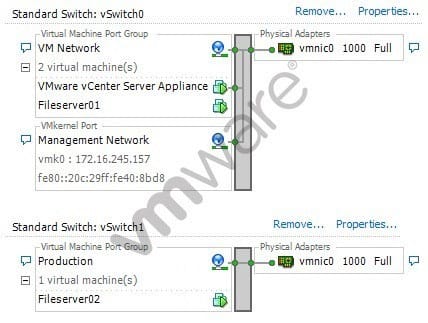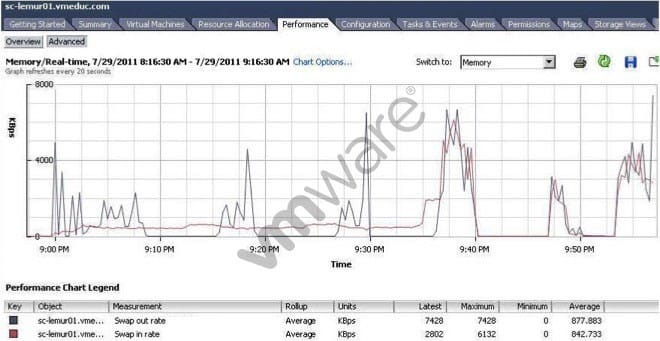Exam Details
Exam Code
:VCP550PSEExam Name
:VMware Certified Professional - Data Center Virtualization (PSE)Certification
:VMware Certified ProfessionalVendor
:VMwareTotal Questions
:270 Q&AsLast Updated
:Apr 16, 2025
VMware VMware Certified Professional VCP550PSE Questions & Answers
-
Question 151:
An application server has been added to an existing multi-tier application contained in a vApp. Shortly after a planned maintenance event, users are unable to access the application.
What does the vSphere administrator need to change to ensure the application can be accessed?
A. The startup order of the vApp
B. The shutdown option to power off the virtual machines
C. The IP Allocation policy to DHCP
D. The Memory Shares to High
-
Question 152:
-- Exhibit -

-- Exhibit -The virtual machine Fileserver01 shown in the exhibit can not ping anything on the Internet.
Why is Fileserver01 unable to connect to the Internet?
A. Fileserver01 does not have a reachable IP address.
B. Fileserver01 is not on the Production network.
C. The virtual nic for Fileserver01 has a speed or duplex mismatch.
D. The vSwitch1 virtual switch does not have an attached vmnic adapter.
-
Question 153:
An administrator using vCenter Operations Manager notices an increase in resource consumption by virtual machines over a period of time. The administrator needs to understand how adding more hosts or increasing resources in existing hosts will address the growing resource requirements of the virtual machines. Which vCenter Operations Manager feature can provide this information?
A. Host or Cluster Capacity Optimization Report
B. What-if Scenarios
C. Density and Reclaimable Waste badges
D. Virtual Machine Optimization Report
-
Question 154:
An administrator needs to configure an alarm that notifies administrators if an application is impacted by overcommitment of memory resources. The environment consists of 100 virtual machines running on 5 ESXi hosts that are configured in a fully automated HA/DRS cluster. The cluster is configured with a parent resource pool and Production and Development child pools. Where should the administrator set the alarm to meet the requirement?
A. On each virtual machine
B. On each host
C. On the Production resource pool
D. On the cluster
-
Question 155:
What action should an administrator take to store ESXi 5.x host system logs centrally?
A. Configure vCenter Server to automatically export log files to a syslog server at regular intervals.
B. Configure vCenter Server to send all log information to a syslog server.
C. Configure each ESXi host to send all log information to a syslog server.
D. Configure the syslog server to import log files from each ESXi host at regular intervals.
-
Question 156:
A vSphere administrator receives a request to capture the state of a virtual machine six times a day. Which procedure will satisfy the requirement with the least amount of administrator intervention?
A. Use the vSphere web client to configure a scheduled task to take a snapshot every four hours.
B. Use the vSphere web client to configure a scheduled workflow to take a snapshot every four hours.
C. Use the vSphere web client to manually initiate a snapshot of the virtual machine every four hours.
D. Use the vSphere web client to schedule an automated snapshot every four hours using Snapshot Manager.
-
Question 157:
-- Exhibit -

-- Exhibit -What is indicated by the performance chart shown?
A. Guest memory is overcommitted.
B. Host memory is overcommitted.
C. Host is I/O constrained.
D. Guest is I/O constrained.
-
Question 158:
An administrator needs to use performance information from Windows virtual machines to better understand their effect on the vSphere 5.x hosts on which they run.
What must the administrator do to collect this information?
A. Install VMware Tools with the PERFMON counters enabled in the Advanced option of the installer.
B. Install VMware Tools. Add counters in the PERFMON utility.
C. Install VMware Tools. Edit the VMware Tools settings to enable the VM-specific counters.
D. Install VMware Tools. Install the PERFMON plug-in for VMware Tools.
-
Question 159:
A vSphere administrator finds a HA/DRS cluster status has turned RED indicating a degraded state. What is the likely reason for the indication?
A. The cluster enabled for HA has lost resources and is unable to fulfill its failover requirements.
B. The cluster does not have enough resources to satisfy the reservations of all resource pools and virtual machines.
C. Incompatible CPU generations between hosts are preventing DRS migrations.
D. The cluster is currently electing a Master host and is unavailable to perform HA functions.
-
Question 160:
Which condition will cause a HA/DRS cluster to display a yellow health indicator?
A. There are insufficient resources to satisfy the cluster's requirements.
B. A virtual machine has failed and cannot be restarted in the cluster.
C. Virtual machine I/O activity in the cluster has reached or exceeded a critical level.
D. One or more hosts in the cluster has entered maintenance mode.
Related Exams:
Tips on How to Prepare for the Exams
Nowadays, the certification exams become more and more important and required by more and more enterprises when applying for a job. But how to prepare for the exam effectively? How to prepare for the exam in a short time with less efforts? How to get a ideal result and how to find the most reliable resources? Here on Vcedump.com, you will find all the answers. Vcedump.com provide not only VMware exam questions, answers and explanations but also complete assistance on your exam preparation and certification application. If you are confused on your VCP550PSE exam preparations and VMware certification application, do not hesitate to visit our Vcedump.com to find your solutions here.